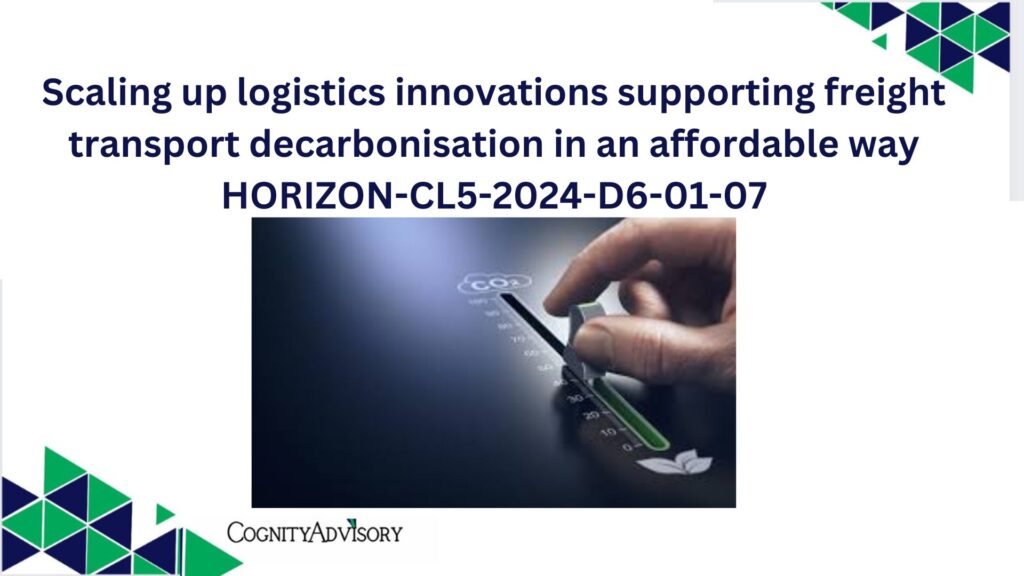HORIZON-CL5-2024-D6-01-07
General information
Programme
Horizon Europe Framework Programme (HORIZON)Budget overview
Call
Type of action
HORIZON-IA HORIZON Innovation Actions
Type of MGA
HORIZON Action Grant Budget-Based [HORIZON-AG]
Open For Submission
Deadline model
single-stage
Opening date
07 May 2024
Deadline date
05 September 2024 17:00:00 Brussels timeTopic description
ExpectedOutcome:
Projects are expected to contribute to all of the following outcomes:
- Reduced greenhouse gas emissions by 55%[1] by 2030 in the project networks, without reducing the overall performance of the logistics supply chain and taking account of all costs and externalities.
- Gains in terms of operational efficiency and environmental impact from the implementation of the Physical Internet[2] are clearly identified, demonstrated and measured.
- Logistics concepts speeding up freight decarbonisation and adoption of zero emissions vehicles/vessels and multimodality are developed.
Scope:
Building on previously funded projects and ongoing activities (e.g. Connecting Europe Facility, Horizon 2020 and Horizon Europe projects), ensuring compliance with the data sharing framework pursued by the Digital Transport and Logistics Forum (DTLF), and taking into account the development of the common European mobility data space, proposals will pilot, demonstrate and scale up systemic collaborative solutions regarding logistics nodes, multimodal logistics networks connectivity, business and governance models. The focus will be on both digital and physical interoperability as well as on the adoption of zero-emission vehicles/vessels.
Proposals will have to research and demonstrate in a structured and systemic way all of the following points:
- Demonstrate at least 10 working open standard processes, procedures and services across several logistics nodes providing seamless access to users. Processes, procedures, and services are expected to have an open access definition and scalability aspects need to be addressed.
- Develop and demonstrate further compatibility and interoperability of the full range of standardised multimodal transport units (from containers to boxes), also across transport modes.
- To achieve scalable multimodal logistics networks connectivity, demonstrate models and processes, supported by Artificial Intelligence, Internet of Things, etc., which can increase utilisation of assets and resources in actual logistics service providers’ networks dynamically. These models should also consider how to increase the adoption of automated and zero-emission vehicles/vessels and the use of rail and inland waterways through multimodal solutions.
- Demonstrate tools, technologies and processes to achieve different types of flows compatibility (e.g. through shared standard boxes) and synchro-modal solutions over the logistics service providers’ networks, involving shippers and retailers to that purpose.
- Demonstrate the benefit (e.g. GHG reductions vs increased operational costs) of decentralised inventory positions in the pooled logistics network allowing low speed multimodal transport for (re-)positioning stock levels and answering short term lead times with closer to consumer inventory positions (e.g. full visibility of inventory positions in retail networks extended to suppliers and logistics service providers).
- Test and demonstrate sound business and governance models and rules (including organisational change requirements) for resource-sharing across logistics networks, to ensure operational efficiency of freight movements irrespective of mode, nodal operations and freight characteristics.
- Test and demonstrate the functionalities and relevance of the data sharing framework, serving for optimisation of the logistic system, including through the establishment of an appropriate semantic model and its components, such as for instance Digital Twins with specific algorithms allowing for predictive planning of logistic related events. Synergies for rail will need to be sought with the EU-Rail Programme projects implementing the Transversal Topic on Digital enablers and Flagship Area 5[3].
- Develop and demonstrate scalability of the proposed solutions providing open access mechanisms and low thresholds to the system of logistics networks. Consider realising visualisation and simulation models and tools to show the practical use of collaborative models for the various types of stakeholders and the potential benefits based on actual cases. Develop specific actions to encourage, facilitate and ensure the access of SMEs and smaller players.
- Measure and demonstrate the benefits in terms of use of resources, affordability of proposed solutions, throughput capacity and environmental impact of the scaled up horizontal collaboration among logistics networks (system of logistics networks).
If projects use satellite-based earth observation, positioning, navigation and/or related timing data and services, beneficiaries have to describe if and how the use of Copernicus and/or Galileo/EGNOS are incorporated in the proposed solutions. In addition, if the activities proposed involve the use and/or development of AI-based systems and/or techniques, the technical and social robustness of the proposed systems is to be described in the proposal.Specific Topic Conditions:
Activities are expected to achieve TRL 7 by the end of the project – see General Annex B.
[1] In line with the 2030 Climate Target Plan the baseline for the greenhouse gas emissions reduction is at least 55% below 1990 levels.
[2] ”The Roadmap to the Physical Internet” was developed in the frame of the EU-funded project SENSE, ref. http://www.etp-logistics.eu/wp-content/uploads/2020/11/Roadmap-to-Physical-Intenet-Executive-Version_Final.pdf
[3] See EU-Rail Multi Annual Work programme at https://shift2rail.org/wp-content/uploads/2022/03/EURAIL_MAWP_final.pdf
